In simple terms, tokenized bitcoin is a way to use the most popular cryptocurrency on non-Bitcoin blockchains such as Ethereum.
This enables users to make the best of both blockchains; combining bitcoin’s price value and brand along with Ethereum’s programmability.
Bitcoin is the most recognized and the largest crypto in terms of market capitalization. However, as we’ve demonstrated several times here at Economy Middle East, most of the innovation these days happens on the Ethereum blockchain thanks to its biggest value-add to blockchain technology, that is, smart contracts.
Smart contracts have helped give rise to the decentralized finance (DeFi) economy, which relies on a whole gamut of decentralized apps (dApps) that power all kinds of financial services on public blockchains. DeFi isn’t restricted to Ethereum, but that’s where all the action is happening these days.
Read More: The Ethereum Ecosystem
So when you tokenize bitcoin, you lock the crypto and instead mint tokens on another network. This, in essence, allows you to use bitcoin as a token on that non-Bitcoin network.
Each token on the other network represents a specific amount of bitcoin. The peg between the two is always kept in sync, such that the process is always reversible. In other words, users should always have the option to destroy these tokens, which should unlock their original bitcoin.
In Ethereum, tokenized bitcoin takes the form of ERC-20 tokens. The positive for the Ethereum ecosystem is that it gains thanks to the large amounts of value and liquidity from Bitcoin. On the other hand, Bitcoin users can use these tokens as a means to tap into Ethereum’s DeFi landscape. Win-Win.
Broadly speaking, there are two different approaches to tokenizing bitcoins – a trusted, centralized approach, and a trustless, decentralized approach.
For instance, BitGo’s wrapped bitcoin (WBTC) is a centralized token. This means users who want WBTC give bitcoin to BitGo, which then issues an ERC-20 token equivalent of bitcoin in return. Users can then use the WBTC token in the Ethereum ecosystem, from selling it on the secondary market to plugging it into a DeFi application.
Then there’s Keep Network’s tBTC, which replaces WBTC’s centralized approach with a distributed network made up of nodes, wallets, and smart contracts. It doesn’t require a trusted entity, and the minting and burning process is handled by automated on-chain processes.
As of November 29, 2022, there are about 258,607 BTC tokenized on Ethereum, as per Dune, and with a supply of 215,871, WBTC takes the top spot among tokenized bitcoins.








